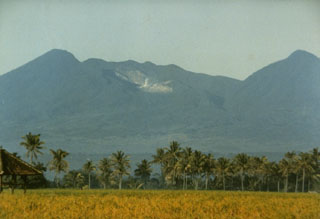Report on Papandayan (Indonesia) — 9 April-15 April 2008
Smithsonian Institution / US Geological Survey
Weekly Volcanic Activity Report, 9 April-15 April 2008
Managing Editor: Sally Sennert.
Please cite this report as:
Global Volcanism Program, 2008. Report on Papandayan (Indonesia) (Sennert, S, ed.). Weekly Volcanic Activity Report, 9 April-15 April 2008. Smithsonian Institution and US Geological Survey.
Papandayan
Indonesia
7.3175°S, 107.7306°E; summit elev. 2643 m
All times are local (unless otherwise noted)
CVGHM reported that the seismic network recorded one volcanic tremor signal from Papandayan on 15 April. On 16 April, measurements of summit fumaroles revealed an increase in temperature and changes in water chemistry since 7 April. White plumes continued to rise to an altitude of 2.7 km (8,900 ft) a.s.l. and did not change. CVGHM increased the Alert Level to 2 (on a scale of 1-4) and reminded visitors and residents not to venture within 1 km of the active crater.
Geological Summary. Papandayan is a complex stratovolcano at the S end of a curved volcanic massif with Kendang volcano ~9 km away at the N end, Gunung Puntang ~3.5 km NNE, and Gunung Jaya ~6 km NNE. Several episodes of collapse have created an irregular profile and produced debris avalanches that have affected lowland areas. The summit area includes four large craters, including the 1.1-km-wide, flat-floored Alun-Alun crater. A sulfur-encrusted fumarole field occupies the active Kawah Mas ("Golden Crater"). The first reported eruption, in 1772 CE, included a collapse of the NE flank and a debris avalanche that destroyed 40 villages and killed almost 3,000 people. Smaller phreatic eruptions occurred during 1923-25, 1942, and 2002.
Source: Pusat Vulkanologi dan Mitigasi Bencana Geologi (PVMBG, also known as CVGHM)

